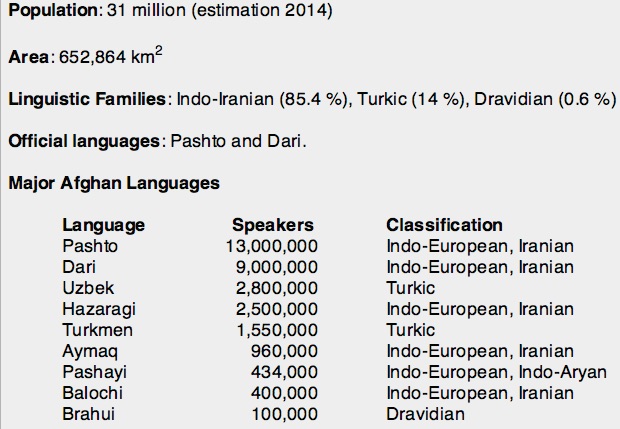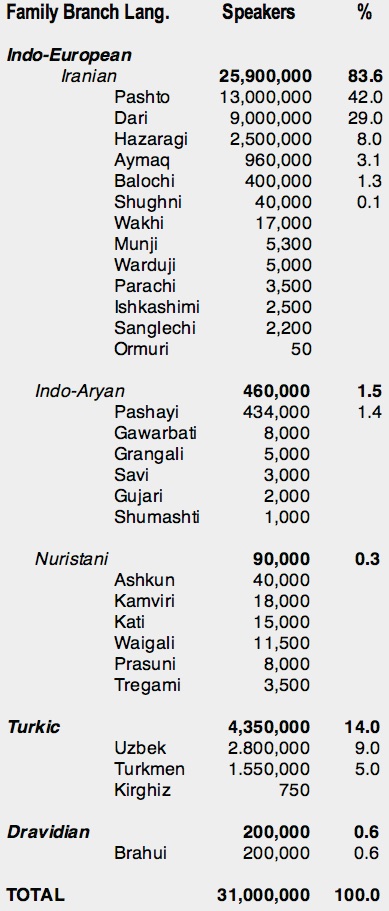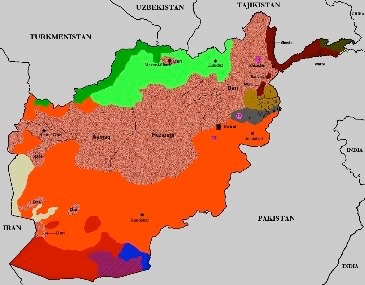Languages and Ethnic Groups of Afghanistan



An insatiable appetite for ancient and modern tongues
Address comments and questions to: gutman37@yahoo.com
As the Language Gulper has no advertisements it is essential that we receive some financial help, however small, in order to keep the site running and eventually expand it.
So, please, make a donation if you can.
Overview. Afghanistan is a landlocked country that became an independent state in 1747 under Ahmad Shah Durrani who, seizing the opportunity provided by the fall of the Safavid dynasty of Iran, the weakness of the Mughals of India, and the fragmentation of the Uzbeks into small khanates, managed to carve out an extensive Pashtun-ruled territory. Before this date, Afghanistan had been part of many empires, and in occasions the center of one: under the Kushans (1st to 3rd c. AD), Ghaznavids (977-mid-12th c.), and Ghurids (mid-12th c.-1215).
The country is situated at the crossroads between Iran, Central Asia and South Asia, a unique geographical position that is reflected in its diverse linguistic and ethnic make-up. Some 30 living languages belonging to three unrelated families are spoken in its territory: Indo-European, Turkic, and Dravidian. The major ones are Pashto and Dari.
Afghanistan borders in the north with Turkmenistan (along 744 km), Uzbekistan (137 km), and Tajikistan (1206 km), in the northeast with China (76 km), in the south and east with Pakistan (2430 km), and in the west with Iran (936 km). Afghanistan main cities are: Kabul (3.3 million inhabitants), Herat (0.5 million), Kandahar (0.5 million), Mazar-i-Sharif (0.4 million), Kunduz (0.3 million), and Jalalabad (0.2 million).
The last census of Afghanistan was completed in 1979. The population in 2014 is estimated to be around 31 million people, inhabiting an area of 652,864 square kilometers. Due to the lack of hard data, there is considerable discrepancy regarding the number of speakers of each language, compounded by the political implications of ethnic and linguistic data in a country that has been ravaged by war during the last four decades.
The major languages of Afghanistan, with at least 100,000 speakers each, are the following:

Language distribution. All of the Indo-European languages of Afghanistan (around 85 %) belong to the Indo-Iranian branch with members of each of its three subdivisions: Iranian, Indo-Aryan and Nuristani.
-Iranian languages predominate in most parts of Afghanistan and include the two major ones of the country, Pashto and Dari, the latter very similar to Modern Persian. Two other important Iranian languages, Hazaragi and Aymaq, are also closely related to Persian while Balochi, and the Pamiri languages are quite different from it. Pashto is spoken south of the Hindu Kush with some pockets in the north, Balochi is spoken in the southwest, while Dari, Hazaragi and Aymaq are spoken north of the Hindu Kush; the Pamiri languages (Shughni, Wakhi, Munji, Ishkashimi, Sanglechi) are spoken by isolated communities in the mountainous northeast (Warduji also spoken in the region is of uncertain classification). Two other Iranian languages, spoken near Kabul, Parachi and Ormuri, are genetically related. Kabul is placed at the boundary between the Pashto and Dari speaking zones and is, in fact, multilingual; while both these languages are popular in the city, several others are spoken because of the continuous migration from rural areas of different parts of the country.
-Indo-Aryan languages are typically spoken in South Asia but one of its branches, the Dardic, extends into the mountainous regions of the Hindukush. Most Dardic languages of Afghanistan are spoken by small minorities that subsist in isolated valleys of the Hindukush close to the Pakistani border; however Pashayi has a substantial number of speakers. Gujari belongs to a different branch of Indo-Aryan being close to Rajasthani, a language of India.
-Nuristani is a small, archaic, group of half-a-dozen languages, spoken by less than 100,000 people, on the southern slopes of the Eastern Hindukush, a region that remained isolated from the outside world until the 20th century. They are thought to predate the split of Iranian and Indo-Aryan.
-Turkic languages (circa 14 %) originated in the steppes of Central Asia, and two of them, Uzbek and Turkmen, are popular in northern Afghanistan, in areas bordering Uzbekistan and Turkmenistan. Kirghiz is spoken by a tiny number of nomads in the remote eastern extreme of the Wakhan corridor.
-Dravidian languages (around 0.6 %) are, apparently, indigenous to South Asia and, with the partial exception of Brahui, are restricted to this region. In Afghanistan, Brahui is spoken in the southeast, close to the Pakistani border, coexisting with Balochi in some regions.
Classification of all Afghan languages. A complete list of Afghanistan living languages ordered by linguistic families and number of speakers is the following:

Ethnic groups of Afghanistan
a) Speakers of Iranian languages
The Pashtuns are the largest ethnic group of Afghanistan constituting between 40% to 50% of the total population of the country. Many more live now in western Pakistan due to the imposition, in 1893, by the British, of an artificial frontier between the two countries (the Durrani line). Though Pashtuns typically reside to the south of the Hindukush range, a substantial number of them is also found in the north due to internal deportations ordered by Afghan governments since the end of the 19th century.
Pashtuns are defined by speaking Pashto, adhering to a common code of conduct (the Pashtunwali) and claiming to descend from a common ancestor called Qais. They are divided into four groups: Durrani, Ghilzai, Gurghusht, and Karlanri. The Durrani Pashtuns, which are based in south and southwest Afghanistan, were politically dominant from the independence of the country until the communist coup of 1978. The Ghilzais, who inhabit eastern Afghanistan, are the largest Pashtun group. Most Pashtuns are subsistence farmers though some are nomads.
The Tajiks are the second largest ethnic group of the country. They speak Dari which is very similar to Tajik (spoken in Tajikistan) and to Farsi (spoken mainly in Iran). In fact, Dari, Tajik, and Farsi are frequently considered as a single language called Modern Persian. They live mostly in the northeast of Afghanistan, where they practice subsistence farming, but also in major cities like Kabul, Mazar-i-Sharif and Herat, where they are merchants or part of the bureaucracy thanks to their knowledge of Persian which was for a long time the language of administration and high culture.
The Hazaras live in the central Hindukush, in a region called Hazarajat. They speak Hazaragi, a dialect of Persian, and, in contrast to the majority, they are Shia Muslims. They practice livestock breeding and subsistence agriculture adapted to their mountainous environment. They were virtually independent until the end of the 19th century when their homeland was conquered by Abdur Rahman, the "Iron Amir", in order to impose a unified central power for the whole country. Until recently, they have been systematically marginalized by successive governments. Many were forcefully displaced and had to migrate to the cities, especially to Kabul.
The Aymaq people speak Aymaq, another dialect of Persian, but are Sunni Muslims. They live to the west of Hazarajat, in the ancient territory of Ghur. Rural Aymaqs are usually semi-nomadic and practice pastoralism growing wheat and fodder for their sheep. They are often called Chahar Aymaq, meaning "four tribes", because they are divided into four groups: Jamshidi, Firozkohi, Taimani, and Taimuri.
The Baluch speak Balochi, an Iranian language different from Persian. They are part of a much larger population inhabiting parts of Pakistan and Iran. In Afghanistan, they live in the desert region of the south, raising sheep, goats, camels, and cattle, practicing nomadic pastoralism; recently many have settled down supporting themselves by farming. In areas close to the Pashtuns, they tend to adopt their neighbors language.
The Pamiris' homeland is in the extreme northeast of Afghanistan, in the province of Badakshan, where they group into several valleys of the western and southern Pamirs extending into neighboring Tajikistan. They speak closely related eastern Iranian languages. Each valley has its own, like Shughni, Wakhi, Munji, Ishkashimi, and Sanglechi. The classification of Warduji, also spoken in the region, is not settled but is unrelated to the Pamir languages. The Pamiris are Shia Muslims of the Ismaili branch, earning a living from subsistence agriculture.
The Qizilbash are descendants from Shia Turkish populations that lived mainly in northwest Persia. Being skilled warriors, they played a key role in the battles that led to the foundation of Afghanistan, and afterwards held important positions in government. Nowadays, they live mainly in cities, engage in commerce and are Persian-speaking, numbering between 100,000 and 200,000.
The Arabs believe they are descendants from the Arabian warriors that invaded Central Asia in the 8th century. They don’t speak the language anymore and speak Persian instead. They are a small minority, assimilated to the mainstream living in pockets, in the north of the country.
b) Speakers of Indo-Aryan and Nuristani languages
Iranian, Indo-Aryan, and Nuristani are considered independent sub-branches of the Indo-Iranian branch. In Afghanistan, Indo-Aryan is represented mainly by the Dardic group. Dardic language speakers and Nuristani speakers live in the same region: the mountains northeast of Kabul, close to the Pakistani border. Their lifestyles are similar, rearing cattle and goats, and practicing terraced agriculture. Dardic and Nuristani languages have comparatively few speakers with the exception of Pashayi. Pashayi speakers adopted Islam first while Nuristanis were compulsorily converted to Islam after their homeland was conquered in 1895. Some migrated, then, to Kabul distinguishing themselves in the military and in the government.
c) Speakers of Turkic languages
Uzbek and Turkmen are major languages of Afghanistan. They are spoken by descendants of tribal confederations of Central Asia that arrived in waves, mainly from the 16th century, reinforced by exiles from the Soviet Union. Turkmens occupy a fringe bordering Turkmenistan while the larger Uzbek populations live in a more extensive area of the north. Most of them are sedentary farmers depending in part of irrigation for their fields. Besides, Turkmen rear karakul sheep and produce carpets for export. In contrast, Kirghiz is the language of a tiny minority of nomads roaming the end of the Wakhan corridor, part of much larger groups living in neighboring countries.
d) Speakers of Dravidian languages
Brahui is the westernmost Dravidian language, a family that is found in southern India, but also in central and northern regions of that country, as well as in Pakistan. Afghan Brahuis migrated, probably, from Pakistan where they are found in much greater numbers. They form a tribal confederation that inhabits the desert areas of the south, close to Pakistan, overlapping with the Baluchis with whom they have coexisted for centuries. They raise sheep and are nomadic, traveling in search of pastures and water wells.
-
© 2014 Alejandro Gutman and Beatriz Avanzati
-
Further Reading
-
- Afghanistan: A Cultural and Political History. Thomas Barfield. Princeton University Press (2010).
-
-The Iranian Languages. Gernot Windfuhr (ed.). Routledge (2009).
-
-‘Dardic’. Elena Bashir. In The Indo-Aryan Languages, 905-990. G. Cardona & D. Jain (eds.)Routledge (2007).
MAIN LANGUAGE FAMILIES
LANGUAGE AREAS
Languages of Ethiopia & Eritrea
LANGUAGES by COUNTRY
LANGUAGE MAPS
-
• America
-
• Asia
-
Countries & Regions
-
-
Families
-
• Europe
-
• Oceania
